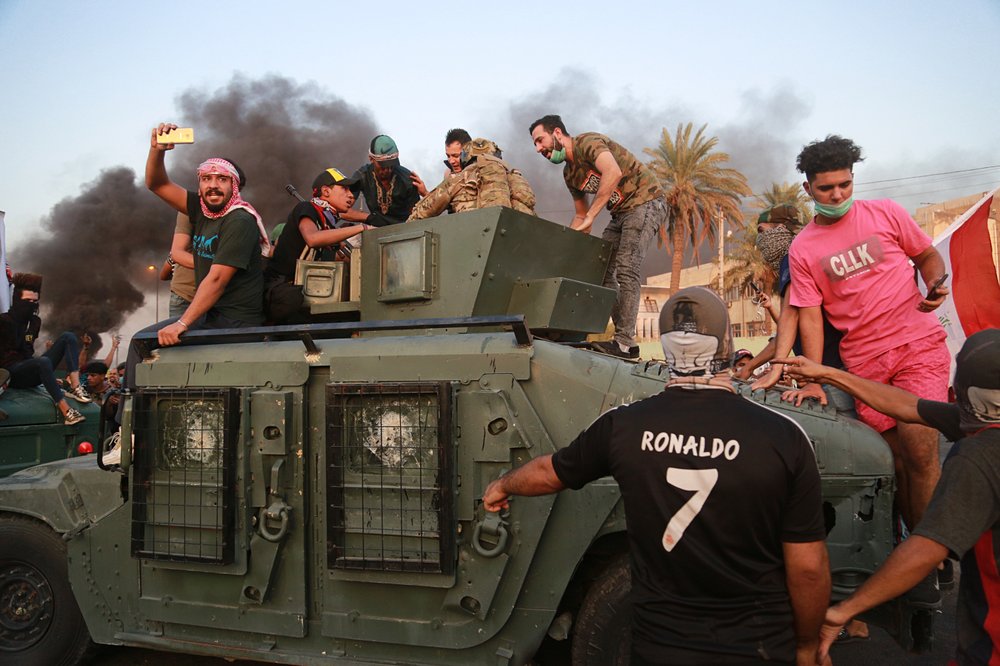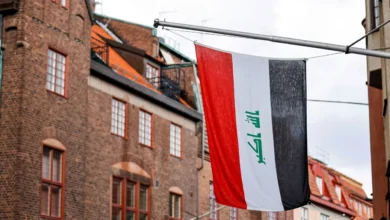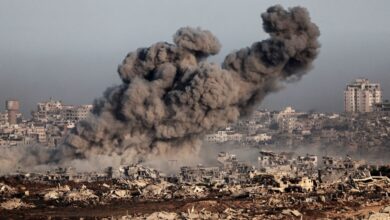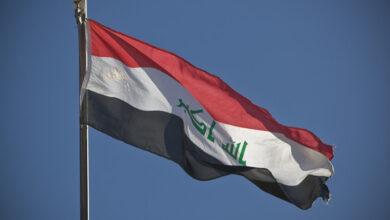
BAGHDAD (AP) — Iraq has been plunged into a new cycle of instability that potentially could be the most dangerous this conflict-scarred nation has faced, barely two years after declaring victory over the Islamic State group in a war that left much of the country in ruins and displaced tens of thousands.
The latest bloody confrontations have killed more than 100 people in less than seven days. But this time, the clashes do not pit security forces against Islamic extremists, the country’s Sunnis against Shiites, or insurgents against occupation forces.
Instead, Iraqi security forces have been shooting at young Iraqis demanding jobs, electricity and clean water — and an end to corruption.
It’s still unclear why the government chose to exercise such a heavy-handed response to a few hundred unarmed demonstrators who first congregated last week on social media to hold a protest. But analysts say the violence has pushed Iraq toward a dangerous trajectory from which it might be difficult to pull back.
As the spontaneous protests — with no apparent political leadership emerging — continued to clash with security forces in Iraq cities and towns, the government appeared unapologetic and failed to offer solutions to entrenched problems, raising fears that yet another Arab nation will be mired in a long-term crisis without a path forward.
“The use of force coupled with cosmetic concessions will work to temporarily ease pressure but will not end the crisis,” wrote Ayham Kamel, Middle East and North Africa head at Eurasia Group. “This cycle of protests could be contained, but the political system will continue to lose legitimacy.”
In their demands for better services and an end to corruption, the protesters are no different from those who rioted in the southern city of Basra over chronic power cuts and water pollution last summer. Or in 2016, when angry demonstrators scaled the walls in Baghdad’s highly secured Green Zone and stormed Iraq’s parliament, shouting “thieves!”
But unlike in 2016 when the protests were led by populist Shiite cleric Muqtada al-Sadr, today’s protests have not been co-opted by any political party. Most are young men in their twenties. They do not have a clear list of demands or a program, nor do they have a spokesman to speak on their behalf. Some are teenagers or fresh university graduates unable to find jobs in a corruption-plagued country that sits on some of the world’s biggest oil reserves.
Their movement — if it can be called that — has no clear contours, nor any quick solutions. The protesters say they are fed up with the entire post-2003 political class which profiteers on kickbacks, nepotism and corruption while ordinary Iraqis drink polluted water and endure massive unemployment.
And most strikingly, the protests are predominantly Shiite demonstrations against a Shiite-led government.
Prime Minister Adel Abdul-Mahdi has promised to address protesters’ demands. But the 77-year-old premier began his tenure last year facing a raft of accumulated challenges, including high unemployment, widespread corruption, dilapidated public services and poor security, and he has told protesters there is no “magic solution for all that.”
The crisis erupted on Oct. 1 after protesters who had organized on social media staged a demonstration calling for their rights. They were met with water cannons, tear gas and bullets. The demonstrations were partially triggered by anger over the abrupt removal of a top Shiite military who led battles against Islamic State militants and was largely seen as a non-corrupt, respected general. But the protesters carried a long list of grievances.
The protests come at a critical moment for Iraq, which had been caught in the middle of escalating tensions between the United States and the regional Shiite power Iran — both allies of the Baghdad government. Iraq’s weak prime minister has struggled to remain neutral amid those tensions.
Adding to the nervousness, mysterious airstrikes blamed on Israel had for weeks targeted military bases and ammunitions depot in Iraq belonging to Iran-backed militias, which vowed revenge against Americans troops stationed here.
The protests, when they started, quickly spread from Baghdad to the Shiite heartland in the south, including the flashpoint city of Basra. The government imposed a round-the-clock curfew and shut down the internet for days, in a desperate attempt to quell the protests.
Interior Ministry spokesman Maj. Gen. Saad Maan said Sunday that at least 104 people have been killed and more than 6,000 wounded in the unrest. He said eight members of the security forces were among those killed and 51 public buildings and eight political party headquarters had been torched by protesters.
The massive crackdown appears to have succeeded in whittling down the number of protesters for now, although sporadic clashes between demonstrators and security forces continue on a smaller scale, including an hours-long gunbattle Monday night near the volatile Baghdad neighborhood of Sadr City.
But among Iraqis and country observers, there is consensus that a dam has been broken and that with so many killed, the protest movement is likely to return, and become better organized next time — whenever that may be.
In a country awash with weapons, there are concerns the violence would lead some protesters to arm themselves, similar to what happened in Syria. There is also worry that some of the hard-line militias loyal to Iran could enter the fray and exploit the chaos.
Muqtada al-Sadr, Iraq’s influential cleric who has a popular Shiite support base and the largest number of seats in parliament, has called on the government to resign because of the large number of people killed. He also suspended his bloc’s participation in the government until it comes up with a reform program.
If al-Sadr joins the protest movement, it will give it much more momentum and potentially lead to even more violence.
Ali Al-Ghoraifi, an Iraqi blogger, said the government may have succeeded in putting a lid on the situation for the time being.
“But it will be like a coal ready to ignite at any time and place,” he wrote in a post. “And when it does, it will burn everyone.”
By ZEINA KARAM and QASSIM ABDUL-ZAHRA
FILE – In this Oct. 3, 2019 file photo, anti-government protesters confront a soldier from the Federal Police Rapid Response Forces before they burn the armored vehicle, during a demonstration in Baghdad, Iraq. The protests have plunged the country into a new cycle of instability since last week, one that could potentially be the most dangerous this conflict-scarred nation has had to face, with more than 100 killed in less than a week. Iraqi security forces have been shooting at young Iraqis demanding jobs, electricity and clean water and an end to corruption. (AP Photo/Hadi Mizban)




